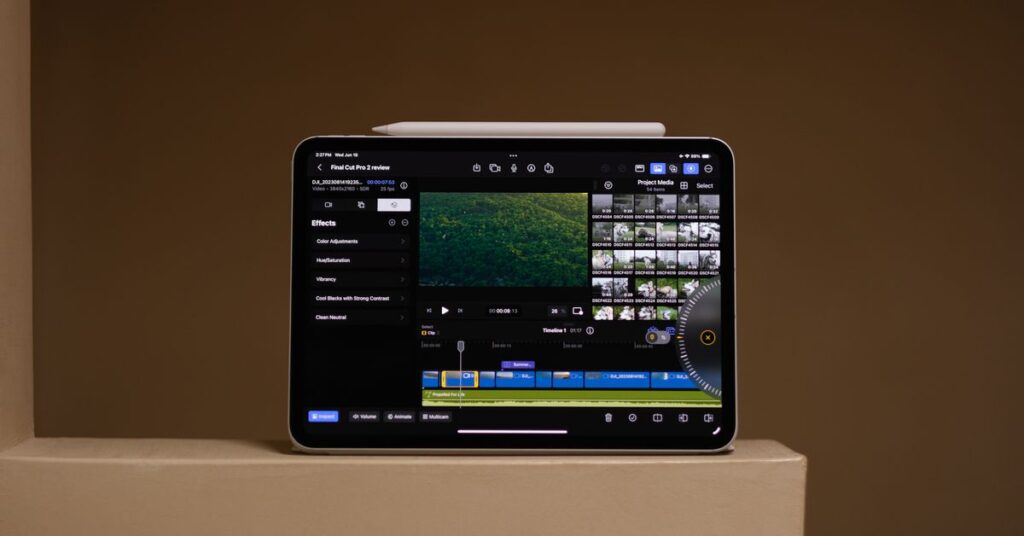For the past two weeks, I’ve been editing in the latest version of Final Cut Pro for iPad. For many professionals, the initial version of the app last year didn’t live up to expectations. Its tools are too limited for daily use. The new version doesn’t necessarily change that – but despite my many frustrations, I finally discovered the joy of using it.
A new version of the app was released this week, confusingly titled “Final Cut Pro for iPad 2” (for all current iPads, not the iPad 2). Perhaps the biggest new feature released this year isn’t exactly a Final Cut Pro feature: it’s a new app integrated with it.
The new Final Cut Camera is a standalone app for iPhone that provides advanced camera control. If you’ve seen the Blackmagic app or the recently released Kino app, you know what to expect: peaking, manual focus, and audio metering. You just can’t add custom LUTs like you can in the other two.
The Final Cut Camera app works with Final Cut Pro on iPad to record live multi-camera sessions and transfer footage from up to four iPhones or iPads. In Final Cut on iPad, you play the role of the director. You can monitor footage from your iPhone, zoom in, and instantly change white balance, focus mode, and more. I can see this new feature being particularly popular with video podcasts.
The previews you see are compressed, but they still look great. Once the recording session is stopped, the full-quality file is transferred to the iPad running Final Cut Pro and rendered. The whole process went much faster than I expected. I had a 10-minute session on three iPhones and was editing within minutes. A new transfer indicator window at the top of the UI shows you progress.
I would like to see an upgrade to this feature in the future: on-the-fly editing. Currently, you still need to end recording before you can sync all files and edit them.
Multicam support is a great new feature, but it stands in stark contrast to Apple’s other efforts to improve the Final Cut Pro for iPad experience. The standout feature of this year’s update is external hard drive support. This is important – this feature was strangely missing last year. But its addition immediately reminded me of how poorly Final Cut Pro for iPad (and iPadOS) handles file management.
All media files must be in an FCP library, and the same library must be stored on an internal or external drive. This means you can’t split media across multiple drives or cloud storage. A side effect of this approach is that it means you’re just constantly copying files from one place to another.
There are other issues that are unchanged from last year. For example, you still can’t import an entire folder into Final Cut Pro, but only a single file. Once imported, you still cannot organize files into separate folders or folders, such as “A-roll”, “B-roll”, “Music” or “Graphics”.
Another new feature exclusive to Final Cut Pro for iPad is instant drawing. Using Apple Pencil, you can draw animations directly on clips. There’s support for Apple’s latest Pencil Pro technology, but other than that, it doesn’t have much to do with the Pencil Pro itself. I wish there was a way to program the tactile squeeze to do more with editing – maybe select multiple clips on hover, or just right click. I find this useful and speeds up using a pencil.
There are a lot of important video editing features I’m waiting for Apple to add: compound clips, folders, adjustment layers, post stabilization, shading tools like curves, project sharing between machines, the ability to add new LUTs, 360 video support, Object tracking, linear keyframes – the list goes on. If you read my review from last year, you’ll see that the exact same list is there.
All of this missing stuff really catches you off guard when you’re in flow. Ultimately, I found myself making creative decisions based on the limitations of poor software.
At the same time, the market for mobile video editing apps is more competitive than ever. CapCut is very popular among TikTok users. “Why I Switched to Da Vinci” videos are all over my YouTube feed. People still use the OG iPad app Lumafusion. In fact, the three features I desperately needed were already available on the Da Vinci iPad app.
But even after trying all the other apps I just listed, I’ll continue to use Final Cut on the iPad even if I’m frustrated by the missing features. Because there’s one thing Apple is doing here, and that’s the overall experience.
Apple calls it a “touch-first” app, and I finally understand what that means. Once you get over the learning curve, once you get the hang of the controls, once you realize its limitations, you start to really enjoy it and have fun. Apple isn’t trying to copy the Final Cut desktop experience – it’s creating a new one. You can see how you interact with the jog wheel and how the sidebar comes in so you can edit with your left hand.
I find that using Final Cut Pro by hand is by far the most immersive way to edit. Literally, everything is within reach. I’m starting to find this more concrete approach attractive, even if it’s not as effective as a mouse and keyboard.
If Apple can easily achieve these goals, then its vision of a powerful, touch-first Final Cut Pro can truly flourish.
Photography: Vjeran Pavic/The Verge

